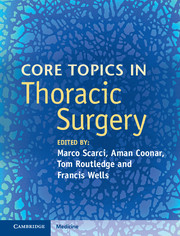Book contents
- Frontmatter
- Contents
- List of contributors
- Section I Diagnostic work-up of the thoracic surgery patient
- Section II Upper airway
- 5 Therapeutic bronchoscopy
- 6 Tracheal stenosis, masses and tracheoesophageal fistula
- Section III Benign conditions of the lung
- Section IV Malignant conditions of the lung
- Section V Diseases of the pleura
- Section VI Diseases of the chest wall and diaphragm
- Section VII Disorders of the esophagus
- Section VIII Other topics
- Index
- References
6 - Tracheal stenosis, masses and tracheoesophageal fistula
from Section II - Upper airway
Published online by Cambridge University Press: 05 September 2016
- Frontmatter
- Contents
- List of contributors
- Section I Diagnostic work-up of the thoracic surgery patient
- Section II Upper airway
- 5 Therapeutic bronchoscopy
- 6 Tracheal stenosis, masses and tracheoesophageal fistula
- Section III Benign conditions of the lung
- Section IV Malignant conditions of the lung
- Section V Diseases of the pleura
- Section VI Diseases of the chest wall and diaphragm
- Section VII Disorders of the esophagus
- Section VIII Other topics
- Index
- References
Summary
Like any hollow viscus in the face of untreated pathology, the trachea can over time develop either symptomatic obstruction or fistula into an adjacent space. Tracheal lesions can be divided according to these two mechanisms.
Obstructive lesions of the trachea (stenosis and masses)
A narrowing of greater than 50% of the cross-sectional area of the trachea by a mass or stricture is necessary before a patient experiences dyspnea at rest. The typical presentation of chronic or subacute tracheal obstruction is the insidious onset of wheezing and shortness of breath that may evolve to stridor and respiratory distress. The finding of tracheal narrowing may not be seen on chest radiographs. Many patients initially receive incorrect diagnoses of asthma or chronic obstructive pulmonary disease and are often treated unsuccessfully with bronchodilators or steroids. Patients with malignant tracheal tumours may report associated hemoptysis and hoarseness, often with a more rapid onset of symptoms.
Axial imaging by computed tomography has superseded linear tracheal tomograms as the imaging study of choice. Three-dimensional reconstruction of images obtained by CT allows virtual bronchoscopy to identify and localize tracheal lesions. Inspiratory and expiratory CT scans are useful to demonstrate tracheomalacia. Pulmonary function testing demonstrating an obstructive pattern may help to suggest the diagnosis but is of limited use in operative planning. Patients with a central airway obstruction will benefit from treatment regardless of pre-operative pulmonary function tests (PFTs).
Bronchoscopy is the mainstay of diagnosis. Relative to flexible bronchoscopy, rigid bronchoscopy with general anaesthesia provides better visualization and control of the airway, precise measurement of laryngotracheal pathology and improved access for biopsy. Rigid bronchoscopy also permits debulking of tracheal lesions and improves tracheal dilatation. Flexible bronchoscopy without the availability of rigid bronchoscopy should be undertaken with caution because of the risk that endoscopic manipulation may lead to abrupt worsening of critical airway stenosis.
Obstructive lesions
Obstructive lesions of the trachea may be extrinsic, intramural or intraluminal. Extrinsic lesions causing tracheal compression include thyroid masses, congenital vascular rings and mediastinal masses. Inflammatory diseases of the mediastinum including tuberculosis, histoplasmosis, sarcoidosis and Wegener's granulomatosis may also lead to extrinsic tracheal obstruction due to lymphadenopathy and fibrosis. Treatment of the underlying cause of extrinsic compression is necessary and usually sufficient to relieve symptoms.
- Type
- Chapter
- Information
- Core Topics in Thoracic Surgery , pp. 48 - 56Publisher: Cambridge University PressPrint publication year: 2016

